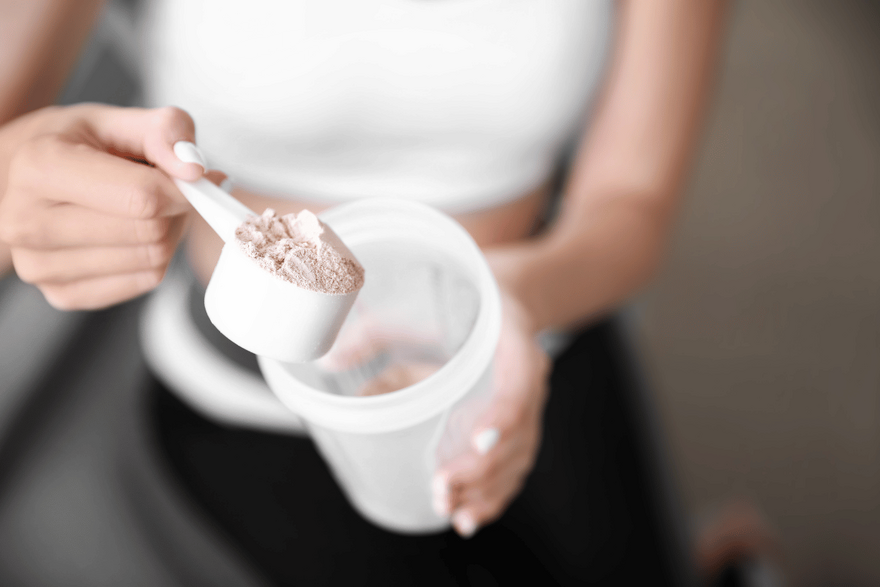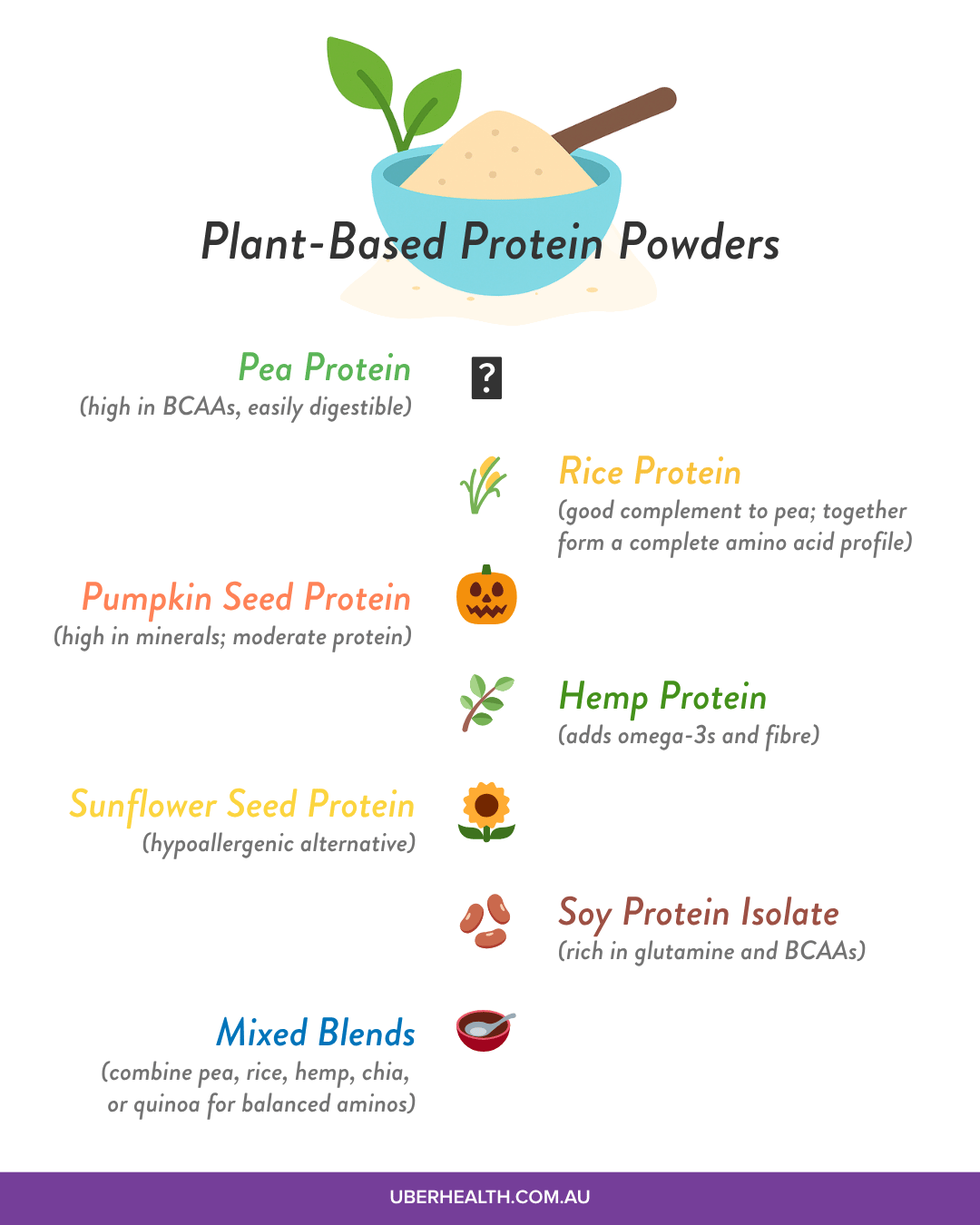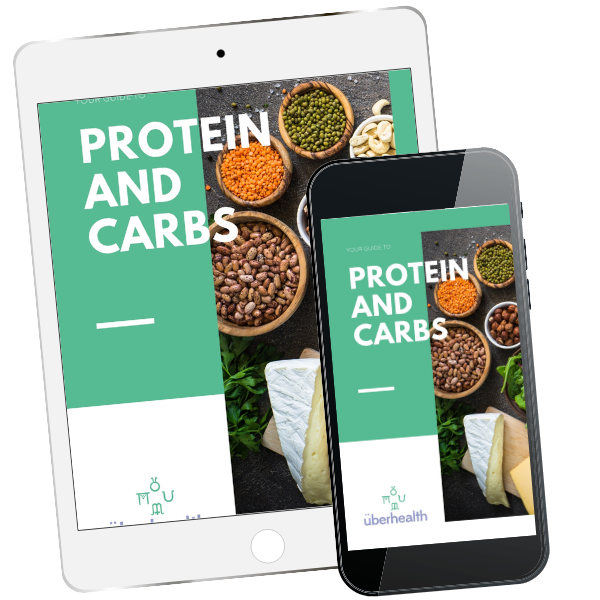Plant-Based Protein Powders in Sports Nutrition

When most people think of protein powders, they picture a big tub of whey sitting on a gym bench. But there’s a whole world of plant-based protein powders that are just as effective for recovery, strength, and everyday energy. And for some, they’re a better choice altogether.
Whether you’re an athlete, an active professional, or someone simply looking to support your health, plant proteins deserve a spot on your shelf.
Why Choose Plant-Based Protein?
Plant-based protein powders are derived from sources like peas, rice, hemp, pumpkin seeds, sunflower seeds, and soy. They provide the amino acids your body needs to repair muscle tissue, support metabolism, and maintain healthy hair, skin, and nails without relying on dairy or animal products.
For some, plant proteins are easier to digest.
For others, they’re a conscious choice for sustainability or managing inflammation and food sensitivities.
And when it comes to performance and recovery, the science backs them up. Studies show that high-quality plant-based blends can match animal proteins in supporting muscle repair and growth as long as you’re getting a good mix of amino acids.
Types of Plant-Based Protein Powders
Here’s a quick breakdown of the most common options and what makes each one unique:
Pea protein powder is one of the most popular options because it’s rich in BCAAs (branched-chain amino acids) — the building blocks for muscle recovery. It’s easily digested, hypoallergenic, and mixes smoothly into shakes.
Rice protein powder on its own is lower in lysine (one of the essential amino acids), but when combined with pea protein, you get a complete amino acid profile. This combo rivals whey for muscle-building potential.
Hemp protein powder offers more than just protein; it’s also a source of omega-3 and omega-6 fatty acids, fibre, and minerals like magnesium and iron. The texture can be a little gritty, but its nutrient profile makes it a winner for endurance athletes and those needing anti-inflammatory support.
Pumpkin seed protein powder is a mineral powerhouse, packed with zinc, magnesium, and iron. It has a mild, nutty flavour and offers a balance of protein and healthy fats, making it a great addition to smoothies or baking.
Sunflower Seed protein powder is hypoallergenic, making it ideal for anyone with sensitivities to soy, nuts, or dairy. It’s also a source of key antioxidants like vitamin E.
Soy protein powder is a complete protein, meaning it contains all nine essential amino acids. It’s one of the most researched plant proteins, known for supporting lean muscle mass, bone health, and hormonal balance (especially in perimenopausal women).
Blends combine proteins like pea, rice, hemp, chia, and quinoa to create a well-rounded amino acid profile. They’re designed to provide all the essentials your body needs for recovery and daily vitality.

Who Benefits Most from Plant Proteins?
Plant-based protein powders are suitable for almost everyone, but they’re especially helpful for:
-
Athletes and active individuals who experience bloating or discomfort from whey or casein.
-
Those reducing dairy for hormonal balance, skin health, or gut reasons.
-
People with food sensitivities or allergies, as many plant blends are gluten-, soy-, and lactose-free.
-
Anyone wanting more variety in their protein intake and nutrient profile.
Even if you’re not vegan or vegetarian, alternating between plant and animal proteins can provide a broader spectrum of nutrients — and it’s often gentler on digestion.
How Plant-Based Protein Powders Are Used in Sports Nutrition
Plant-based protein powders aren’t just for vegans — they’ve become a key tool in sports nutrition for athletes of all levels. Whether you’re a runner, triathlete, cyclist, or gym enthusiast, these powders help bridge the gap between training demands and real-life food prep.
Here’s how and why they’re used in athletic nutrition plans:
1. Post-Training Recovery
The main reason athletes reach for protein powder (plant or otherwise) is recovery. After intense training, your muscles are primed to absorb amino acids and rebuild damaged tissue. Plant-based protein powders (especially blended ones like pea + rice) provide a complete amino acid profile to:
-
Rebuild muscle tissue
-
Reduce post-exercise soreness
-
Support glycogen replenishment when combined with carbohydrates
Tip: Aim for about 20–40 g of protein within 30–60 minutes after training. Add a banana or oats to your shake for a balanced carb-to-protein ratio (3:1 is ideal).
2. Daily Protein Support
Even with the best diet intentions, athletes sometimes fall short on daily protein needs — especially if they follow plant-based or dairy-free diets.
Protein powders offer a convenient way to:
-
Boost intake between meals
-
Meet higher training demands
-
Balance macronutrients without adding excess fat or fibre
Plant proteins like pea, hemp, or soy mix easily into smoothies, porridge, yoghurt, or snacks, helping maintain steady amino acid availability throughout the day.
3. Pre-Training Fuel for Endurance Athletes
Before long sessions, a small protein-containing meal or smoothie can help stabilise blood sugar and reduce muscle breakdown. Light, easily digested plant proteins (such as pea or rice) can be blended with fruit and plant milk for sustained energy without heaviness.
Example: Smoothie with banana, pea protein, oats, and almond milk. Gentle on the gut, especially before early-morning runs.
4. Overnight Recovery and Adaptation
While casein (a milk-based protein) is often used for slow-release overnight recovery, athletes who avoid dairy can use mixed plant-based blends instead. These provide gradual digestion and support the body’s repair processes during sleep, which is crucial for recovery in multi-day training or competition blocks.
5. Supporting Gut and Inflammation Balance
Some athletes experience bloating or mucus congestion from dairy-based proteins. Plant proteins are naturally anti-inflammatory and often easier on digestion. Hemp and pumpkin seed proteins, in particular, supply omega-3s and magnesium, both of which support inflammation management and muscle relaxation.
6. Customising Nutrition for Dietary Preferences
With the rise of vegan and flexitarian athletes, plant-based proteins make it easier to meet protein goals while aligning with ethical or environmental values. They also suit athletes with lactose intolerance, dairy sensitivities, or IBS-type gut issues, offering flexibility without compromising performance.
7. Blending for Complete Amino Acids
Not all plant proteins are complete on their own. That’s why sports nutritionists often recommend blends — for example:
-
Pea + rice → complete amino acid profile
-
Hemp + chia → adds omega-3s and minerals
-
Soy + pumpkin seed → enhances glutamine and magnesium intake
These combinations ensure that plant-based athletes can perform and recover just as effectively as omnivores.
How to Use Plant-Based Protein Powders
Plant-based proteins mix well into:
-
Smoothies or post-training shakes
-
Overnight oats or breakfast bowls
-
Pancake or muffin mixes for extra protein
-
Stirred into yoghurt or plant-based milk
Tip: aim for around 20–40 grams of protein after training for optimal recovery. Combine your protein powder with a source of carbohydrate (like fruit, oats, or coconut water) for faster glycogen replenishment.
| Type of Protein Powder | Protein (approx. per 1 scoop / 30 g serve) | Protein (approx. per teaspoon / 5 g) | Notes |
|---|---|---|---|
| Pea Protein | 20–25 g | 3–4 g | High in BCAAs; very digestible |
| Rice Protein | 22–24 g | 3–4 g | Lower in lysine; pair with pea for full amino profile |
| Hemp Protein | 12–16 g | 2–3 g | Also provides fibre, omega-3s, magnesium |
| Pumpkin Seed Protein | 16–18 g | 2.5–3 g | Rich in minerals, moderate protein |
| Sunflower Seed Protein | 18–20 g | 3 g | Hypoallergenic; good all-rounder |
| Soy Protein Isolate | 25–27 g | 4–5 g | Complete protein, high in glutamine & BCAAs |
| Mixed Plant Blends | 20–25 g | 3–4 g | Pea + rice or hemp + chia offer balanced amino acids |
Why Plant-Based Protein Deserves a Place in Every Athlete’s Plan
Plant-based protein powders are no longer the grainy, chalky options of years past. They’re now clean, effective, and scientifically validated for supporting recovery, muscle repair, and overall wellness.
Whether you choose pea, hemp, or a mixed blend, the right plant-based protein can help you recover faster, feel lighter, and perform better naturally.
Written by Kira Sutherland, Sports Nutritionist (BHSc, Adv.Dip.Nut, Naturopath)
Helping athletes and active individuals fuel smarter, recover faster, and perform at their best.
FREE RESOURCE


